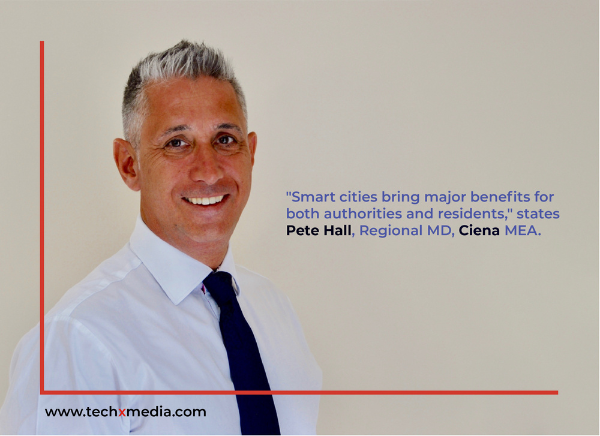
By Pete Hall, Regional Managing Director, Ciena Middle East & Africa
The deployment of 5G in the Middle East is leading to many exciting possibilities for people and governments. A GSMA report estimates that 45 million 5G connections will be activated by 2025 across the Middle East and North Africa (MENA), accounting for 6% of total mobile connections in the region, and driving smart city innovation.
The UAE has adopted several key initiatives to improve its urban infrastructure and enhance the quality of life for citizens, including the launch of the ‘Smart Dubai 2021 Strategy’, which aims to provide integrated daily life services, optimize the use of city resources, anticipate risks, protect people and information and personalize business experiences for all.
Well-planned smart cities offer significant benefits to authorities as well as residents. While they empower the administration to easily and better manage infrastructure, city dwellers benefit from improved and sustainable government services including healthcare, education, transportation, energy and public safety, among others, and prompt response from the administration.
Of course, creating a smart city – one that is connected and automated wherever possible via a strong, secure communication network – is no easy task. It requires an extensive system of sensors, devices analytics and data centers designed to maximize the use of available resources to improve the quality of life for citizens.
Initially, most smart city projects are focused on specific applications, such as smart lighting or traffic management, managed by individual agencies. However, the concept has evolved with several technologies and agencies working in tandem to maximize the benefits. Data generated from the projects needs to be shared between agencies so it can be used for better management and to ensure an improved experience for citizens, and it now requires a more converged connectivity platform, enabling easy sharing of data between all the stakeholders.
AI and ML driving need for flexible networks
While Artificial Intelligence (AI) and Machine Learning (ML) have long been ingrained in various aspects of technology, the growth of AI in its many forms is resulting in even more actionable and real-time insights for city administration to leverage. Now AI, ML and the scale of cloud resources can help city administration deliver precise, predictive analysis based on vast quantities of data. This allows them to quickly resolve a problem or proactively address a situation even before it starts to impact the citizens.
Of course, such smart city applications use data and bandwidth-intensive technologies that require network flexibility and agility. A smart city requires a highly reliable network that allows the city management to introduce new technologies quickly and at scale. This is crucial because the demands from city infrastructure are constantly evolving and the administration should be able to meet them quickly and easily.
An adaptive network that offers a combination of network intelligence, software control and automation and programmable infrastructure would help city administration address these needs. Analytics and intent-based policies of adaptive networks allow city management to scale rapidly while self-configuring and self-optimizing by regularly evaluating network pressure and demands.
The growing number of smart city initiatives require a programmable network that can address the requirement for fluctuations in bandwidth, traffic prioritization and avoidance of network congestion and outages. This is a challenge for most service providers, as identifying the root cause and resolving service issues across multi-layer networks in real-time using conventional service assurance tools could take significant time and effort. This negatively impacts business productivity and increases operational expenses, not to mention, violates the Service Level Agreements and customer churn.
A unified, automated approach that simplifies service assurance across multi-layer networks helps in quick identification and resolution of the problem’s root cause. Ciena’s Blue Planet intelligent automation platform analyses alarms and alerts across network infrastructure and in case of a direct relationship, the problem is swiftly identified. This approach helps in bringing down the time to resolution thus ensuring improved customer satisfaction.
Smart cities must utilize new technologies to build a future-ready network infrastructure that allows them to make a city smarter and truly enrich the lives of citizens in urban spaces. With the UAE and Saudi Arabia at the helm of smart city technology adoption, it will be critical for governments and operators to facilitate data collection to make cities more sustainable and efficient.